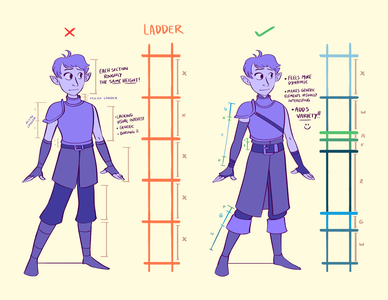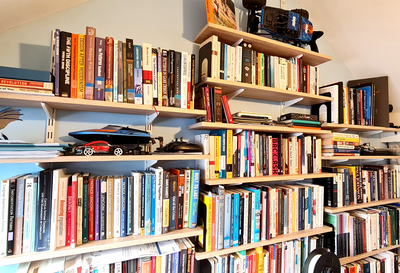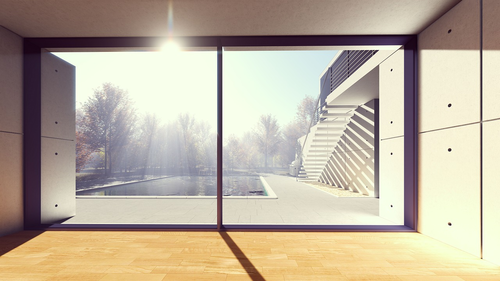Property 1 — Levels of Scale
Levels of Scale is introduced in
As elements in a design grow in size or gain sub-elements, how those elements relate to each other can have varying levels of potency or relevance. What’s notable is that sub-elements of a superior structure tend not to be extreme in this variation.
When an identifiable design element has become too large, it can need splitting. When the shape of a design starts to become too complicated, it can be better to make it a compound of smaller parts. You can turn a more prominent or complex element into several smaller components without weakening its identity in each case. The new features will be healthier when they maintain excellent scale ratios with their neighbours.
A good design often has multiple levels of scale within the hierarchy or web of interconnected elements. These levels must be well proportioned. The scale relationship is between neighbouring sub-elements in the larger design or direct descendants in a hierarchy.
When the subdivision occurs, some sub-elements will strongly support the meaning in the outer element. Some will help it less, even though they are crucial, because not attending to these differences in relevance and scale can lead to designs that feel off-balance.
When designing characters for computer games, animations or graphic novels, characters may look drab if they are too regimented in their details. The vibrance and sense of life immediately increase in the example, where the sizes of each defined part differ but not by too much.
 Character design benefits from levels of scale (Image courtesy of Johanna Taylor
https://johannamation.com)
Character design benefits from levels of scale (Image courtesy of Johanna Taylor
https://johannamation.com)
We often see these cascading proportions in older buildings, furniture, or artwork, but not so much in modern creations. For example, look at a modern bookshop or library. You may find all the square spaces are the same size. Modular and regular with no variation of scale. The ordering of the books is more important than goodness of fit.
This property is generally missing from modular design due to the inherent nature of mass production. Modules tend to come in a small number of standard sizes and fit together in columns, rows, and grids. It’s efficient in terms of time to think and come up with a design, but not always an efficient use of space.
 Standard-sized shelves leave quite a bit of space and are too small for some large
books.
Standard-sized shelves leave quite a bit of space and are too small for some large
books.
Observe the furnishings in an older library or house and you will see shelves of different heights and widths. Even the ubiquitous Swedish furniture item, the Billy bookshelf, has variation in scale with its alcoves. There’s a practical reason for this: books themselves are different sizes. Levels-of-scale has value in simply allowing things to conform when their scale is relatively similar.
I appreciate this observation. Accommodation for all does not mean dropping to the least common denominator but instead offering alternatives. My bookshelf uses a modern modular shelf design, but the modules have the local flexibility I need. I can accommodate all sorts of different book sizes and the occasional radio-controlled vehicle or pocket electronic device.
 My bookshelves are different sizes, packing in various books, toys, and electronics.
My bookshelves are different sizes, packing in various books, toys, and electronics.
The well-performing scale proportions all roughly fall within a set range. Christopher Alexander states the most comfortable scale ratios are between 2:1 and 4:1 at the greatest[NoO1-01]. Think about the sizes of rooms in your home. Nothing is 20 times as big as its neighbour. I also think there’s a lower level to these levels, something like a 3:4 ratio. These pleasant ratios must be pronounced differences. If the difference is only slight, it does not appear to be an intentional effect, just an irregularity. If it’s small enough, and repeated throughout the form, say less than 1% difference, it’s a sense of flexibility in the realisation. Perhaps it is just me, but at ratios of between 4:5 and 7:8, the differences look like mistakes.
When things don’t have these ratios, they can feel a little inhuman, such as when there are giant single-pane windows with thin frames, it can feel like you are in a goldfish bowl. You can be alienated from the outside, even though you literally see more of it than with a smaller, better-proportioned window. When you see small fasteners on large pieces of wood, it can feel like it’s there as a temporary measure while work progresses. Things feel unfinished.
 Somehow alienating, even though there is so little keeping you separate.
Somehow alienating, even though there is so little keeping you separate.
In a form with comfortable levels of scale, you will often see substantial borders or things framed in gentle steps of magnitude. You see it in buildings with dado rails and skirting boards. When the scale is too extreme or not significant enough, it looks strange. We also see it in books. Sometimes, the text or headings are the wrong size for the script beneath. Images might be the wrong size for the layout of a page or the quantity of text it shares the space with. However, a well-constructed page can be a pleasure to view, even if you cannot understand the language of the text.
Levels of scale is the property of good proportions for different elements in the same compound. You can find good and bad examples in font design, website and page layout, cars, and consumer product design.
Sometimes, scale helps identify an area as separate. When enclosed within a larger space, a scale difference provides further meaning to a division. A couch or half wall placed well in a room can divide it so that we give each side meaning—living and leisure against eating. One is a world of softness and relaxation, and the other is a world of utility, quick to clean and a space where we prepare for duty. If these spaces were the same size, if the wall were directly in the middle, both areas would feel wrong. One takes precedence in your life, so reflect that with which is given more of the volume.